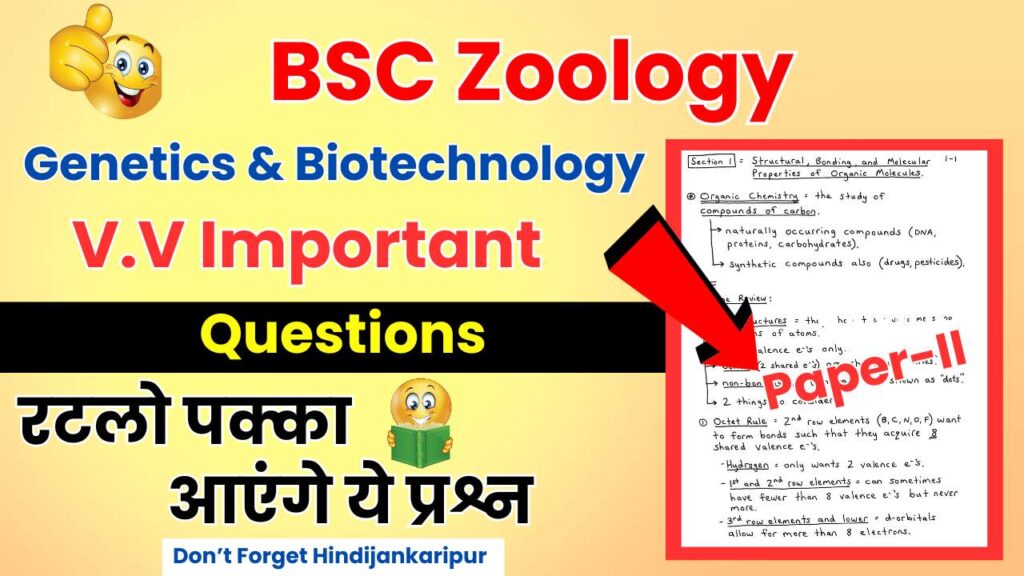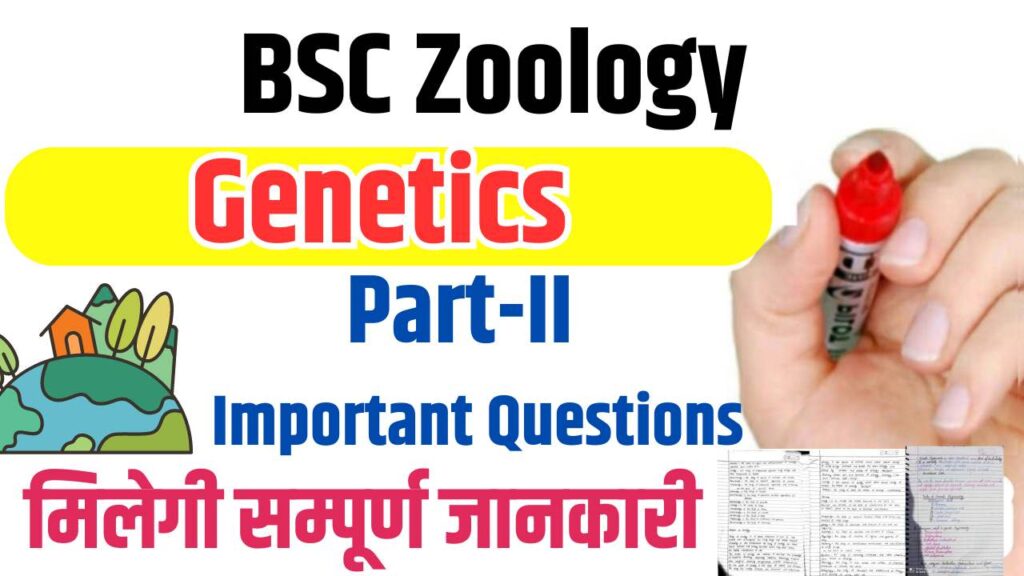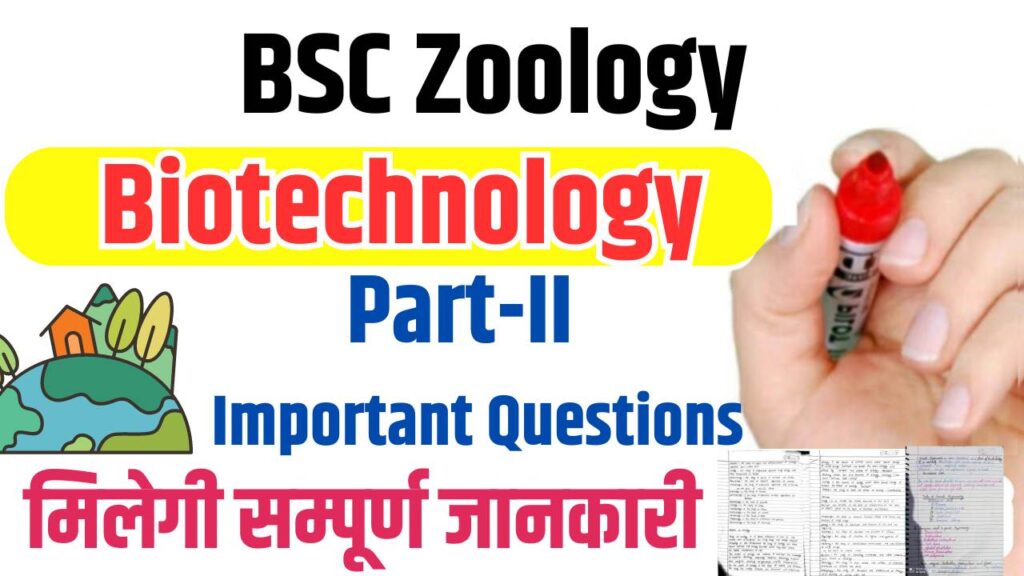Studying BSC Zoology Paper-ii Genetics and Biotechnology Important Questions is Good for your Exam Preparation. They Can Help You To Cover Maximum Syllabus In Minimum Time.
Zoology Is A Difficult Subject if You Lack Knowledge About Its Topics. In This Post We Have Compiled Some important BSC Zoology Paper-ii Genetics and Biotechnology Important Questions.

These Bsc Zoology Genetics and Biotechnology Important Questions Mentioned Here Are Extracted From Previous Year Question Papers And They Help You Learn Important Knowledge about BSC Zoology Paper-ii Genetics and Biotechnology Important Questions…
Contents
- BSC Zoology Paper-ii Genetics and Biotechnology Important Questions
- Genetics
- Biotechnology
- What is Biotechnology?
- How is the copy number of plasmid vector and yield of the recombinant protein related to each other?
- What are the Principles of Biotechnology?
- How is Biotechnology useful in developing food crops and in agriculture process
- What are the different types of biotechnology?
- What is a bioreactor? Explain different types of bioreactors.
- What is a polymerase chain reaction? What are the steps involved? Mention its applications.
- Mention any three vector-less methods that are used to introduce recombinant DNA into a competent host cell.
- What are competent cells? What does the word “competent” refer to?
- How are competent cells prepared by the action of CaCl2?
- What is the role of proteases added while isolating DNA?
- If the “denaturation” step is missed during PCR, what would be its effect on the entire process?
- How is a DNA viewed on an agarose gel?
- A mixture of the fragmented DNA was run on an agarose gel. The gel was stained with ethidium bromide but no bands were observed. What would be the cause?
- Name a recombinant vaccine.
- How is Ti plasmid of Agrobacterium tumefaciens modified to convert it into a cloning vector?
- Do biomolecules such as DNA, proteins exhibit biological activity in anhydrous conditions?
BSC Zoology Paper-ii Genetics and Biotechnology Important Questions

Genetics

What is Genetic Engineering?
Genetic engineering is the direct manipulation of an organism’s genes using biotechnology.
Why is DNA present in every cell of our body?
DNA contains the genetic instructions for the development, functioning, growth, and reproduction of all known organisms and many viruses.
What would happen if restriction enzymes do not cut the DNA at specific recognition sequences?
If restriction enzymes fail to cut DNA at specific sites, the process of gene cloning would be hindered as the DNA fragments would not be properly prepared for ligation into vectors
.
What is the role of Agrobacterium tumefaciens in plant transformation? Agrobacterium tumefaciens is used in genetic engineering to introduce foreign genes into plant cells, which can lead to the development of transgenic plants with desirable traits
.
What are the features of a plasmid being used as a cloning vector? A plasmid used as a cloning vector should have features like an origin of replication, selectable markers, and unique restriction sites to facilitate the cloning process
.
What do you understand by gene cloning? Gene cloning is the process of making multiple, identical copies of a piece of DNA, typically a gene, within a host organism
.
What are the properties of a good vector? A good vector should have a high copy number, selectable markers, and unique restriction sites to ensure efficient cloning and selection
.
What would happen if a plasmid without a selectable marker was chosen as a cloning vector? Without a selectable marker, it would be challenging to distinguish between host cells that have taken up the plasmid and those that have not
.
Biotechnology

What is Biotechnology?
Biotechnology is the use of living systems and organisms to develop or make products, or “any technological application that uses biological systems, living organisms, or derivatives thereof, to make or modify products or processes for specific use”.
The copy number of a plasmid vector is directly proportional to the yield of the recombinant protein; higher copy numbers can lead to higher yields.
What are the Principles of Biotechnology?
The principles of biotechnology involve the use of living organisms or enzymes from organisms to produce products and processes useful to humans.
How is Biotechnology useful in developing food crops and in agriculture process
Biotechnology can improve food crops by enhancing nutritional content, yield, and resistance to pests and diseases, thereby benefiting agriculture.
What are the different types of biotechnology?
There are several types of biotechnology, including medical, agricultural, industrial, and environmental, each with specific applications and techniques.
What is a bioreactor? Explain different types of bioreactors.
A bioreactor is a device or system that supports a biologically active environment, with types including stirred-tank, airlift, and fluidized bed bioreactors, each designed for specific bioprocesses.
What is a polymerase chain reaction? What are the steps involved? Mention its applications.
Polymerase chain reaction (PCR) is a technique used to amplify a segment of DNA across several orders of magnitude, involving steps such as denaturation, annealing, and extension. Its applications include DNA cloning, gene analysis, and forensic science.
Mention any three vector-less methods that are used to introduce recombinant DNA into a competent host cell.
Three vector-less methods include microinjection, biolistics or gene gun, and electroporation.
What are competent cells? What does the word “competent” refer to?
Competent cells are those that have the ability to take up naked DNA from their environment, a condition that can be induced in the laboratory.
How are competent cells prepared by the action of CaCl2?
Calcium chloride treatment alters the cell membrane to make it permeable to plasmid DNA, thus preparing the cells to become competent.
What is the role of proteases added while isolating DNA?
Proteases are added during DNA isolation to degrade proteins and remove them from the DNA preparation.
If the “denaturation” step is missed during PCR, what would be its effect on the entire process?
Missing the denaturation step in PCR would prevent the separation of DNA strands, thereby inhibiting the amplification of the target DNA sequence.
How is a DNA viewed on an agarose gel?
DNA can be visualized on an agarose gel after electrophoresis by staining with ethidium bromide, which intercalates with DNA and fluoresces under UV light.
A mixture of the fragmented DNA was run on an agarose gel. The gel was stained with ethidium bromide but no bands were observed. What would be the cause?
The absence of bands could be due to insufficient DNA, degradation of DNA, or failure to properly stain or visualize the gel.
Name a recombinant vaccine.
One example of a recombinant vaccine is the hepatitis B vaccine, which is produced by inserting a segment of the hepatitis B virus gene into yeast cells.
How is Ti plasmid of Agrobacterium tumefaciens modified to convert it into a cloning vector?
The Ti plasmid is modified by removing its disease-causing genes and inserting the desired gene, which can then be introduced into plant cells.
Do biomolecules such as DNA, proteins exhibit biological activity in anhydrous conditions?
Biomolecules like DNA and proteins generally require a hydrated environment to exhibit biological activity; they may not function properly in anhydrous conditions
Also Read: Importance of Microbiology in Different Fields
We hope that with the help of this article you would have got information about Bsc Zoology Animal Diversity Part-I Important questions
Friends, how did you like this post, please let us know in the comment section and if you have any questions, then feel free to ask us in the comment box. If you found this post useful please share it with others.